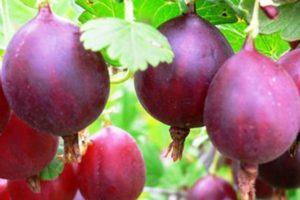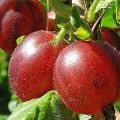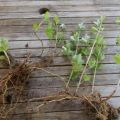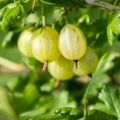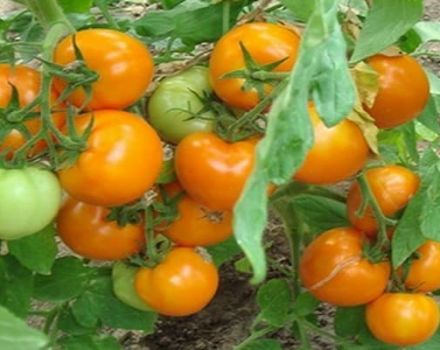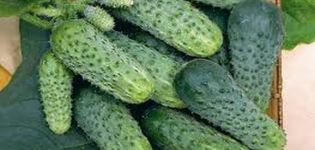Causes of diseases and pests of gooseberry, treatment and control of them
Many summer residents plant gooseberry bushes in the garden, which are easy to grow. Such a plant does not need careful care and grows well in any climatic conditions. However, sometimes the bushes become infected with diseases that negatively affect the yield. Therefore, before planting, you need to familiarize yourself in detail with gooseberry diseases and methods of their treatment.
Why gooseberry bushes are ill
There are several reasons why a planted gooseberry bush can get sick with this or that disease and die.
External factors
Plant diseases often appear due to external factors. Experienced gardeners do not recommend growing berries at low temperatures and high humidity. In such conditions, rot forms on the root system, which leads to further death of the bushes.
Also, diseases appear in the second half of summer, when the bushes weaken due to the heat and the rapid drying of the soil. To prevent yellowing and leaf fall due to moisture deficiency, the plants will have to be watered daily.
Care errors
Some diseases begin to affect the bushes due to improper care. There are several common mistakes that inexperienced gardeners make:
- Application of sprinkler irrigation method. If you use sprinkler irrigation, yellow plaque and mold appear on the surface of the leaves. When a large amount of moisture gets in, the leaves begin to dry.
- Careless loosening. Sometimes people carelessly loosen the soil and accidentally touch the root system with a hoe. This leads to the development of fungal and infectious diseases.
- Improper fertilization. It is recommended to treat the soil with organic and mineral fertilizing mixtures to saturate it with nutrients. If this is not done, the gooseberries will weaken and start to hurt.
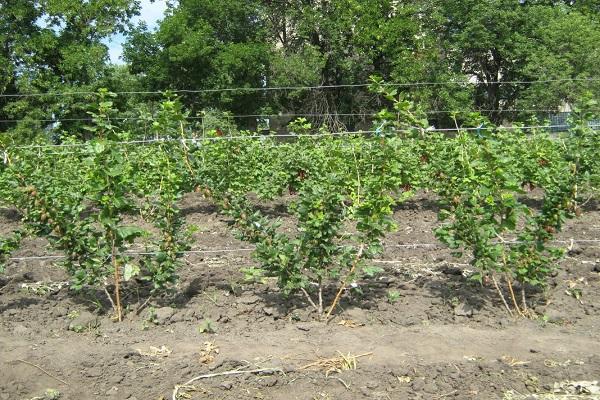
Poor quality planting material
An infectious or fungal infection of the bushes can occur due to the use of low-quality planting material.For planting, choose the healthiest green seedlings, the leaves of which have not begun to curl. If there is a white or red coating on the leaves, you should not plant them.
Wrong place
Another reason why plants start to hurt is the wrong choice of a place for planting and further growing. Gooseberries should not be in the shade often, and therefore planting should be carried out in the most illuminated area of the garden. The shaded area is not suitable for planting, as in the shade the gooseberry fruit will develop worse. Also, in shaded areas, there is increased soil moisture, which contributes to the appearance and development of certain diseases.
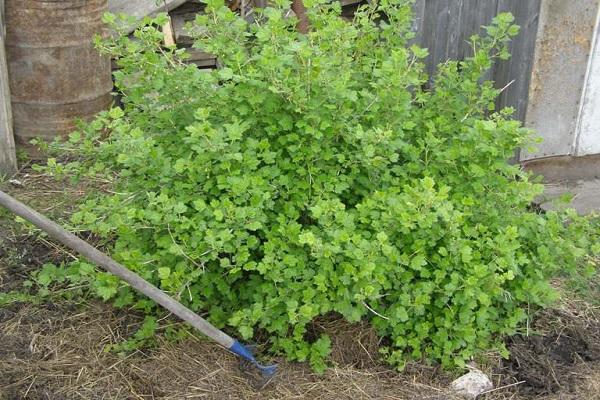
The main diseases of the gooseberry: characteristic symptoms and methods of struggle
Before planting gooseberries, it is necessary to study in more detail the diseases of the gooseberries and measures to combat them. Description of diseases and ways to eliminate them will help to cure gooseberry bushes faster.
Spheroteka
Most often, gooseberry gardeners have to deal with spherotek. The first symptoms of the disease appear after flowering ends. The main features of the spheroteca include a brown coating on the surface of the leaves, which can be erased. Gradually, the disease spreads to each leaf of the bush. If the spheroteka is not promptly cured, the bushes will die.
When treating the disease, use the following means:
- Watering plants with hot water. The best time to use boiling water for watering is in spring. It is in the spring that spheroteka spores are found in the soil, which infect the bushes.
- Top dressing. To prevent the onset and development of the disease, a mixture made from wood ash is periodically added to the soil.
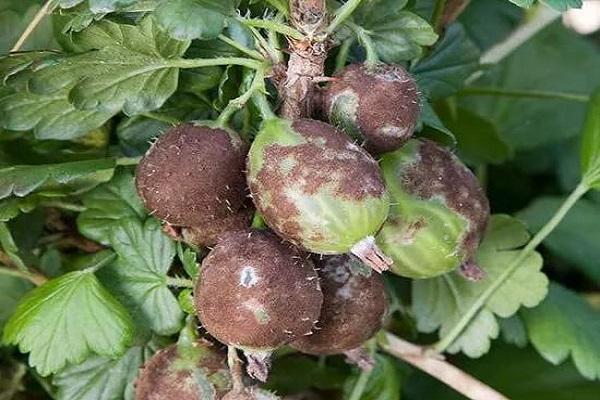
Anthracnose
Summer is a time when many gooseberry bushes are infected with anthracnose. In order to timely identify the disease, it is necessary to periodically examine the leaves. With the development of anthracnose, a darkish bloom appears on them, which gradually covers the entire surface. All affected leaves begin to turn yellow, dry out and fall off. When the first signs of anthracnose appear, treatment is immediately carried out, during which they use:
- Potassium salt. It is a highly effective solution to help get rid of the disease. Spray the infected bushes 2-3 times a week.
- Manganese solution. The mixture is used to prevent anthracnose. It is used in early spring, before flowering.
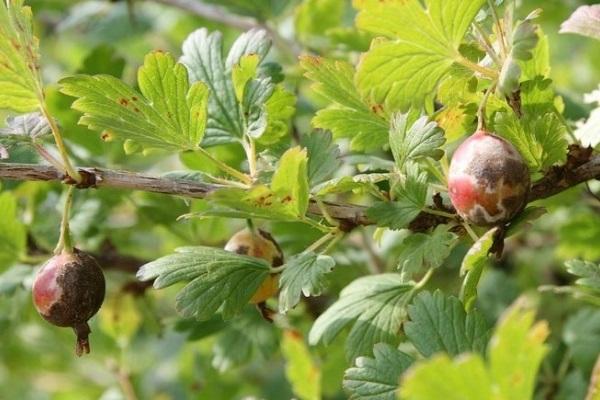
White spot or septoria
Septoria is a common pathology from which any berry can die. The causative agent of the disease is a fungus that develops on a leaf plate. In bushes that are infected with white spot, foliage turns yellow and falls off.
Experienced gardeners advise treating spotting with a solution containing wood ash. This tool is used for spraying the surface of the soil and bushes.
Goblet rust
Goblet rust appears at the beginning of the growing season. Most often, signs of the disease appear at high temperatures and high humidity. Gooseberries get rusty from weeds that can grow nearby. Therefore, it is recommended to regularly remove the grass to protect the bushes.
Among the symptoms of rust, spotting on the leaves is distinguished, which has a brown color. Gradually, brown spots from the leaves pass to the stems of bushes and berries. If you do not get rid of goblet rust, the fruiting of gooseberries will worsen. To get rid of the disease will help ammonia and Bordeaux mixture.
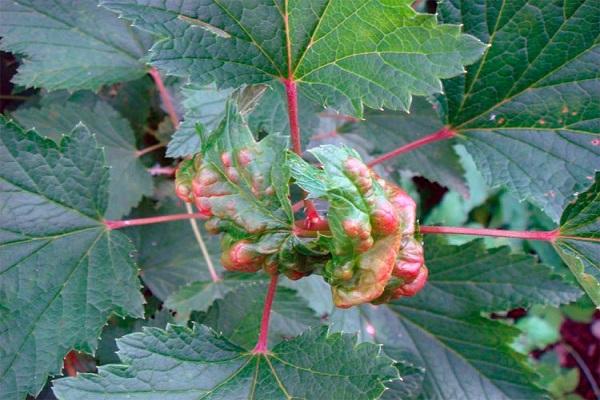
Gooseberry mosaic
The main reason for the appearance of the disease is the use of non-disinfected garden tools when pruning stems. With the development of pathology, a long spot appears along the veins of the leaves, which has a gray color and a yellowish tint. Mosaic bushes stop growing.Twisting of the leaves also appears, which makes them wrinkled and small.
The mosaic cannot be cured and therefore diseased plants will have to be disposed of. All diseased bushes are dug up with roots, dried and burned.
Powdery mildew
Powdery mildew is one of the most common diseases that can cause leaves to turn yellow and fall off. The peculiarities of pathology include the fact that no remedy can cure it.
In plants infected with powdery mildew, leaves and ovary dry out. The surface of the foliage and stems gradually begins to cover with a white powdery coating. Also, the disease spreads to the fruits, due to which the yield decreases at times.
To prevent the spread of the disease to healthy gooseberry bushes, the infected plants will have to be dug up.
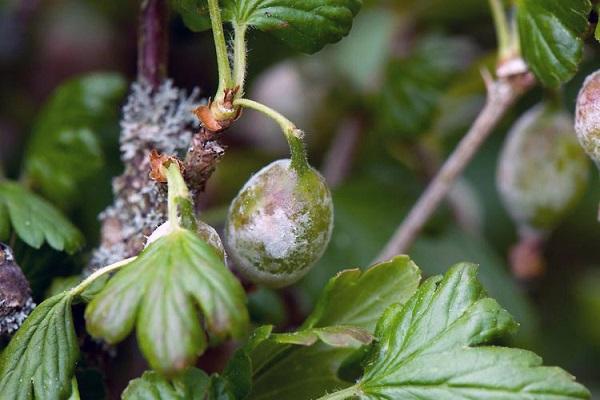
Columnar rust
Autumn is the period when gooseberries become infected with columnar rust. The disease develops in cloudy weather and high humidity. An increased level of soil acidity also contributes to the development of rust.
First, signs of the disease appear on the sheets located below. Then the plaque, which has a copper color, spreads to branches, ovaries, flowers and even berries. If the rust is not immediately removed, the plant will slowly die. Spraying the plants with Bordeaux solution will help to eliminate the disease.
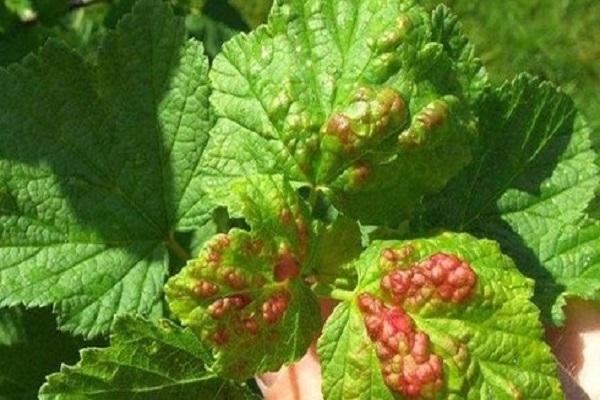
Symptoms and treatment of gray rot
Gray rot is considered a dangerous fungal disease, due to which gooseberry bushes can die. Most often it appears if the berries are poorly looked after.
Symptoms of pathology appear immediately and therefore it is quite easy to find diseased bushes in a timely manner. The development of gray rot is evidenced by brown-gray spots on the stems, which will eventually appear on the surface of young berries.
For the treatment of rot, a mixture is used, which includes ash and copper sulfate. About five liters of solution are consumed per square meter of the site.
Symptoms and treatment of shrinking shoots
People who have been growing berries for many years often face drying out of the shoots. The main symptom of the disease is that the bark of the branches is covered with cracks and becomes less elastic. If this fungal disease is not cured, the affected branches will completely die.
To eliminate the disease, Bordeaux solution is used, with which the bushes are treated at least once every ten days.
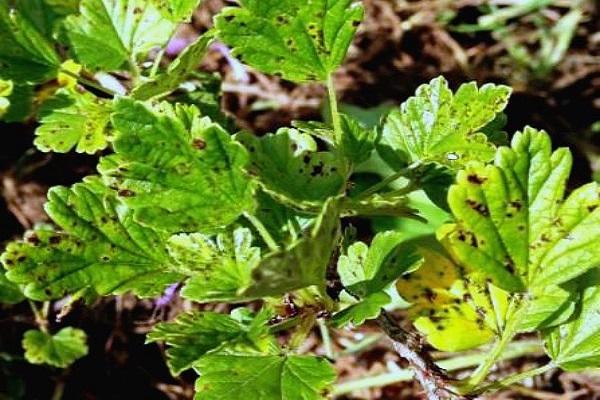
Mechanical damage to the gooseberry
There are times when gooseberry bushes die due to mechanical damage. The most common injury is a broken bud or branch. This problem appears due to construction work near plants, heavy snowfall or wind gusts.
The place of the break begins to rot, which leads to the drying of the branch. To preserve the broken off twig, the damaged area is disinfected with a solution that includes alcohol and covered with oil paint.
Gooseberry pests and control
Gooseberry pests often lead to a deterioration in the growth and fruiting of bushes. There are several insects that most often attack berries.
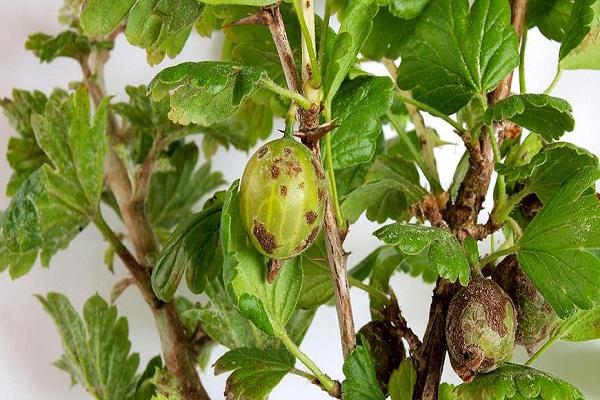
Currant goldfish
This is a dangerous insect that is often encountered when growing berries. The main harm is caused by a young larval caterpillar, which penetrates into the shoots and feeds on them. Stems containing goldfish stop growing and become covered with yellow dots. If you do not use a remedy against goldsweet in a timely manner, gooseberry shoots will begin to die off.
When eliminating the pest, citric acid or urea is used. The bushes are sprayed 3-4 times a week.
Currant gall midge
Some gardeners believe that only currants suffer from this pest, but this is not the case. The pest often attacks young gooseberry seedlings and impairs yield.Adults lay eggs in the bark of plants. Over time, larvae grow from the eggs, which penetrate into the shoots and feed on the juice.
A folk solution made from urea and vitriol will help get rid of pests. You can also use such insecticidal agents as Karbofos and Topaz.
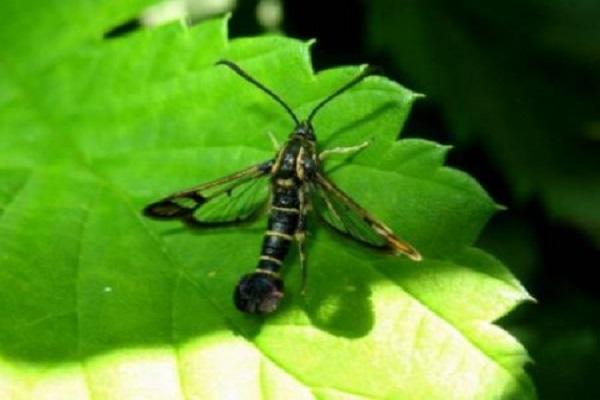
Gooseberry moth
This insect has a short life cycle, but this does not prevent it from harming many plants. Adults lay the larvae in a cobweb cocoon. After 10-15 days, larvae grow, which gradually penetrate the gooseberry leaves and begin to suck the juice out of them. At first, on each leaf, a small merged point appears. However, over time, practically nothing remains of the leaves.
In the fight against the moth, Fitosporin and other biological products are used.
Gooseberry sawfly
The sawfly is a dangerous insect with a yellow coloration and spots that are black. The pest penetrates the leaves in the spring and eats out small holes on their surface. If the gooseberry is not processed in time, the sawfly will eat the whole leaf plate. Biological preparations, which include "Dendrobacillin" and "Lepidocide", are considered effective agents against this insect.

Gooseberry moth
Many are interested in why gooseberry berries fall. Often the reason for the fall of gooseberry fruits is the moth. This small butterfly is able to reduce the yield of bushes by 2-3 times.
Adult butterflies lay eggs on leaves, from which larvae emerge. They gradually eat up leaves and stems. This leads to yellowing and drying of the seedlings.
Gardeners advise periodically dropping moth larvae from the sheets. However, this does not always help to get rid of the pest and you have to use more effective means, which include tar solution from soap.
Currant glass
A common autumn pest, the larvae of which feed on plant sap and leaf plates. The glassyard attacks all varieties of currants and gooseberries.
It is not easy to get rid of the glass pan, since most of the time it is inside the branches. When cleaning a bush from a pest, boric solution and chemicals are used.
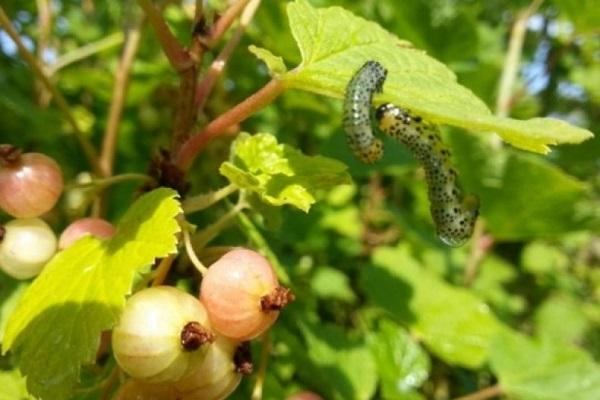
Spider mite
This is a dangerous insect that attacks not only berries, but also indoor plants. It is difficult to notice spider mites, since they are located on the inside of the leaves. You must get rid of ticks immediately, as they multiply quickly.
An effective remedy against a pest is a mixture that contains laundry soap and soda. Gooseberries are sprayed with soapy water 3-4 times a month.
Sprout aphid
Aphids are a massive pest that can destroy the bush within two days. The main measure for preventing the appearance of aphids is digging up the soil. It is recommended to dig the site in September or October. If the aphid has already attacked the plant, use iron vitriol or Bordeaux mixture, which is sprayed on the branches.

Prevention of diseases and insect infestations
To prevent scab and other dangerous diseases from appearing on the gooseberry, preventive measures must be taken in advance. There are several preventive measures that will help protect plants:
- Compliance with crop rotation. It is recommended to replant the bushes to a new place every 5-6 years.
- Site cleaning. It is necessary to periodically clean the area of weeds.
- Correct care. Plants that are properly cared for are less likely to get sick. During the care of the gooseberry, it is periodically watered and fed so that the bushes have enough nutrients and moisture.
Conclusion
Many gardeners are engaged in the cultivation of gooseberries.Before planting this berry, you need to familiarize yourself with the main causes of the appearance of the disease of the bushes, as well as understand the most effective methods of dealing with infectious and fungal varieties.
